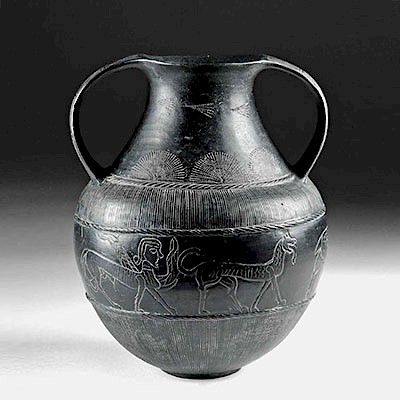Beautiful Bactrian Stone Pillar Idol
Lot 108a
About Seller
Artemis Gallery
686 S Taylor Ave, Ste 106
Louisville, CO 80027
United States
Selling antiquities, ancient and ethnographic art online since 1993, Artemis Gallery specializes in Classical Antiquities (Egyptian, Greek, Roman, Near Eastern), Asian, Pre-Columbian, African / Tribal / Oceanographic art. Our extensive inventory includes pottery, stone, metal, wood, glass and textil...Read more
Categories
Estimate:
$2,500 - $3,500
Absentee vs Live bid
Two ways to bid:
- Leave a max absentee bid and the platform will bid on your behalf up to your maximum bid during the live auction.
- Bid live during the auction and your bids will be submitted real-time to the auctioneer.
Bid Increments
| Price | Bid Increment |
|---|---|
| $0 | $25 |
| $300 | $50 |
| $1,000 | $100 |
| $2,000 | $250 |
| $5,000 | $500 |
| $10,000 | $1,000 |
| $20,000 | $2,500 |
| $50,000 | $5,000 |
| $100,000 | $10,000 |
| $200,000 | $20,000 |
About Auction
By Artemis Gallery
Mar 21, 2019
Set Reminder
2019-03-21 10:00:00
2019-03-21 10:00:00
America/New_York
Bidsquare
Bidsquare : Fine Ancient | Asian | Ethnographic Art
https://www.bidsquare.com/auctions/artemis-gallery/fine-ancient-asian-ethnographic-art-3967
Featuring classical antiquities, ancient and ethnographic art from cultures encompassing the globe, plus fine art. Egyptian, Greek, Roman, Etruscan, Near Eastern, Asian, Pre-Columbian, Native American, African / Tribal, Oceanic, Spanish Colonial, Russian, Fine Art, so much more! Artemis Gallery info@artemisgallery.com
Featuring classical antiquities, ancient and ethnographic art from cultures encompassing the globe, plus fine art. Egyptian, Greek, Roman, Etruscan, Near Eastern, Asian, Pre-Columbian, Native American, African / Tribal, Oceanic, Spanish Colonial, Russian, Fine Art, so much more! Artemis Gallery info@artemisgallery.com
- Lot Description
Ancient Central Asia or Asia Minor, Bactria, ca. 3rd to 2nd millennium BCE. A beautiful example of a pillar idol (sometimes called a column idol), hand-carved and meticulously smoothed from a mottled black stone with white and beige inclusions. The body of the idol is minimalistic and highly-abstract with an elongated hourglass form, and the lower end curves out gently to a wide, planar base. Both the upper and lower faces bear shallow, horizontal grooves across the center. An intriguing example of abstract artistry from the ancient world! Size: 5.25" W x 11.4" H (13.3 cm x 29 cm).
Stone idols like this example are known in a variety of fascinating forms throughout the pre-literate ancient world. From the truly abstract kilia-type figures that are barely recognizable as human to the exaggerated feminine shapes of so-called "Venus" figures, people in the past, as today, had a clear desire to portray human forms and did not feel constrained by naturalism.
A stylistically-similar example of a slightly larger size hammered for $11,250 at Christie's, New York Antiquities auction (sale 2007, June 4, 2008, lot 69): https://www.christies.com/lotfinder/ancient-art-antiquities/a-bactrian-stone-ritual-object-circa-late-5078804-details.aspx?from=searchresults&intObjectID=5078804&sid=c215dd00-7518-481b-8184-986e1b6f1fd4
Provenance: private East Coast, USA collection; ex-Tomatsu Miura collection, Japan, collected in the 1990s
All items legal to buy/sell under U.S. Statute covering cultural patrimony Code 2600, CHAPTER 14, and are guaranteed to be as described or your money back.
A Certificate of Authenticity will accompany all winning bids.
We ship worldwide and handle all shipping in-house for your convenience.
#140493Small repairs to chipped areas on upper and lower faces, with small losses and light adhesive residue along break lines. Minor abrasions to body and both faces, with traces of likely-modern red and blue-green pigment along body. Light earthen deposits throughout. Old inventory number written in silver marker on upper face, and old inventory label on bottom face.Condition
- Shipping Info
-
All shipping is handled in-house for your convenience. Your invoice from Artemis Gallery will include shipping calculation instructions. If in doubt, please inquire BEFORE bidding for estimated shipping costs for individual items.
-
- Buyer's Premium



 EUR
EUR CAD
CAD AUD
AUD GBP
GBP MXN
MXN HKD
HKD CNY
CNY MYR
MYR SEK
SEK SGD
SGD CHF
CHF THB
THB















